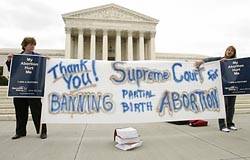Is Summer’s First Spectacle Spidey’s Last Stand?
Spider-Man 3 is a movie stuffed to bursting — with action, plotlines, characters, humor, energy, moods, spectacle and certainly inspiration.
Like its web-headed hero careening crazily through the canyons of Manhattan at the end of a web-line, the film swings breathlessly and without warning from one thing to another, from breakneck excitement to outrageous silliness to comic-book morals about responsibility, sacrifice and, now, even vengeance and forgiveness.
Popcorn cinema, especially super-hero cinema, frequently runs out of steam by the second or third act. It’s always tired by the second or third installment. Bucking the trend, Spider-Man 3 may be the freshest and most unique of the series, completing the trilogy without a hint of franchise fatigue. If it doesn’t quite deliver on all its promise, at least the filmmakers have erred in the direction of trying for too much rather than settling for too little.
The original Spider-Man related how Peter Parker (Tobey Maguire) became Spider-Man. Spider-Man 2 explored Peter’s difficulties juggling his dual identities and his growing resentment over the hardships of being Spider-Man. By Spider-Man 3, Peter has his double act together — so much so that he’s swinging toward the opposite extreme, becoming complacent and full of himself.
These days, everybody loves Spider-Man. The media loves him. New York loves him. He gets a parade and even the key to the city. Of course Mary Jane loves him, though he may be taking that one too much for granted. Still, he wants to marry her. This gives Aunt May (Rosemary Harris) a chance to offer one of her trademark moral speeches.
“A man has to be understanding and put his wife before himself,” she admonishes. “Can you do that?”
Peter thinks he can, but there’s a certain lack of conviction and maturity in his tone. Peter’s love for MJ has always been a schoolboy crush and, even in his third outing as Spider-Man, Peter hasn’t really grown up. He’s still living an adolescent fantasy, not yet fully grasping that the power of love brings great responsibility.
Meanwhile, Harry Osbourne (James Franco) is out to kill Peter. Also, an alien is stalking him, photographer Eddie Brock (Topher Grace) is horning in on his work at the Daily Bugle, a fugitive named Flint Marko (Thomas Hayden Church) has been transformed into a walking sandstorm, Uncle Ben’s real killer may still be at large, MJ’s Broadway career hits the skids, Peter’s lab partner Gwen Stacy (Bryce Dallas Howard) is really cute — and, if all these transitions seem a bit abrupt, well, the movie is like that too.
And that’s not all. When the alien, a symbiote (a comic-book organism that bonds with another living organism in order to survive), catches up with Peter, it transforms Spider-Man into Dark Spider-Man — and Peter into Dark Peter. Dark Peter is the polar opposite of Spider-Man 2’s Sunny Peter, briefly seen in a whimsical sequence scored to “Raindrops Are Fallin’ on My Head” and, if you thought that bit was loopy, you ain’t seen nothin’ yet.
Are these too many characters, too many storylines? Well, yes. Like last summer’s Pirates of the Caribbean: Dead Man’s Chest, Spider-Man 3 is creativity run amok, which is certainly preferable to creativity struggling to put one foot in front of the other. Although somewhat uneven compared to the outstanding Spider-Man 2, this film’s heights are series high points — and it’s consistently head and shoulders above the original film, which remains the weak link in the series.
Still, the energy and ambition isn’t without tradeoffs. One of Spider-Man 2’s highlights was Alfred Molina’s Dr. Octopus, a flawed but decent human being who fell prey both to ambition and to the subversive influence of his own technology. Octopus’s arms became a character in their own right; the scenes of Octavius trying to resist their whispering suggestions while they wove about his head like the serpent in the garden were among the film’s most effective moments.
Spider-Man 3 had a gold-plated opportunity to revisit this theme with the introduction of Venom, a composite character created when the alien symbiote finds another host. The opportunity was squandered. The symbiote never becomes the character Octavius’s arms were; we learn nothing of its motives or feelings at being cast off by Peter, though these are well established in the comic books. (By contrast, the second film went beyond the comic books in how it treated Octopus’s arms.)
Marko, also known as the Sandman, has more poignancy, though his character development consists mostly of looking sorrowfully at a locket picture of his daughter. Actually, the most emotionally moving scene with the Sandman — as well as the film’s most beautiful scenes, and one of the most technically impressive — is a pure effects sequence involving an undulating heap of sand as Marko tries to pull himself together for the first time after the transformation.
Even Harry Osbourne falls a little short of the complex character he should be after three films, though he ultimately elicits surprising sympathy. (Franco’s smile in this film looks eerily like that of Willem Dafoe, who played his father in the first film.)
Although there is certainly room for more Spider-Man films, Spider-Man 3 wraps up a number of story arcs spanning all three films, essentially completing the trilogy in grand style. At the very least, Spider-Man 3 confirms that the second film was no fluke.
Still, if there are more films to come — the studio has mentioned a second trilogy — it remains to be seen if the filmmakers can finally take Peter past his extended adolescence and let him finally become Spider-Man in fact as well as in name.
Steven D. Greydanus is editor and chief critic of DecentFilms.com.
- Keywords:
- May 06-12, 2007














